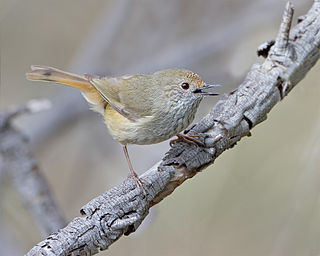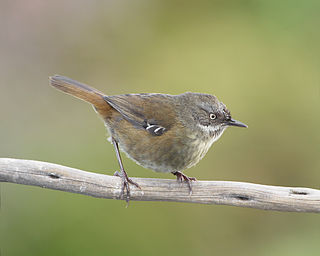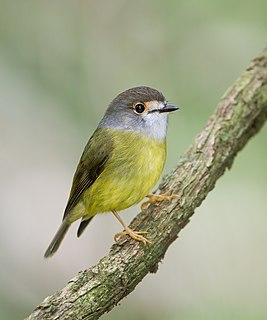
Pardalotes or peep-wrens are a family, Pardalotidae, of very small, brightly coloured birds native to Australia, with short tails, strong legs, and stubby blunt beaks. This family is composed of four species in one genus, Pardalotus, and several subspecies. The name derives from a Greek word meaning "spotted". The family once contained several other species now split into the family Acanthizidae.

The red-browed pardalote is a small brightly coloured insectivorous passerine, endemic to Australia. A gleaning specialist, they forage primarily in eucalypt trees . The Latin word rubricatus means red-ochred which is descriptive of their orange-red eyebrow. Other common names include red-browed diamondbird, bellbird, cape red-browed, pale red-browed, fawn-eyed, fawn-eyebrowed and pallid or red-lored pardalote.

The brown thornbill is a passerine bird usually found in eastern and south-eastern Australia, including Tasmania. It can grow up to 10 cm (3.9 in) long, and feeds on insects. It is brown, grey and white. The species has five subspecies.

The yellow-rumped thornbill is a species of passerine bird from the genus Acanthiza. The genus was once placed in the family Pardalotidae but that family was split and it is now in the family Acanthizidae. There are four subspecies of yellow-rumped thornbill. It is a small, brownish bird with a distinctive yellow rump and thin dark bill. It inhabits savannah, scrub and forests across most of Australia and eats insects. The species engages in cooperative breeding.

The weebill is a species of bird in the family Acanthizidae. It is an insectivorous passerine that is found throughout mainland Australia. At 8 to 9 cm long, it is Australia's smallest bird. It was originally described by John Gould in 1838, and four subspecies are recognised. The weebill's plumage is nondescript, with olive-grey upperparts and paler, more yellowish underparts. It grades from more brownish plumage in the southern regions of Australia to more yellow in tropical areas.

The yellow-throated scrubwren is a passerine in the family Acanthizidae that is found in parts of eastern coastal Australia. It was formerly placed in the genus Sericornis, but is now the only species in the genus Neosericornis.

The chestnut-rumped thornbill is a small passerine bird in the family Acanthizidae, endemic to Australia.

The scrubtit is a species of bird in the thornbill family Acanthizidae. It is endemic to Tasmania and King Island in Australia. Its natural habitat is the temperate rainforest, Nothofagus beech forest and eucalypt woodland. It is a small species that resembles the Sericornis scrubwrens.

The southern whiteface is a small passerine found in arid regions across most of the southern half of the Australian continent, excluding Tasmania. Superficially finch-like in appearance, this insectivorous bird is relatively common throughout most of its range, however, overall populations appear to be in decline.

The speckled warbler is a species of bird in the family Acanthizidae. It is endemic to eastern Australia. Its natural habitat is temperate forests.

The strong-billed honeyeater is a species of bird in the family Meliphagidae. It is one of two species of the genus Melithreptus endemic to Tasmania. Its natural habitat is temperate forest.

The fernwren is a species of bird in the family Acanthizidae. It is monotypic within the genus Oreoscopus.

Sericornis is a genus of small, mainly insectivorous birds, the scrubwrens in the family Acanthizidae. Despite the similarity in shape and habits, the true wrens (Troglodytidae) are a quite unrelated group of passerines.

The Tasmanian scrubwren or brown scrubwren is a bird species endemic to the temperate forests of Tasmania and nearby King Island. It lives in the understory of rainforest, woodland, dry forest, swamps and coastal scrublands.

The large-billed scrubwren is a passerine bird in the family Acanthizidae, endemic to eastern Australia. It is found in denser undergrowth in temperate forest, subtropical or tropical moist lowland forest, and subtropical or tropical moist montane forest.

The pale-yellow robin is a species of passerine bird in the family Petroicidae. It is endemic to eastern Australia. Its natural habitat is subtropical or tropical moist lowland forests. It is a nondescript bird with grey head and olive upperparts, white throat and yellow underparts. The sexes are similar. Two subspecies are recognised: the smaller nana from North Queensland, and the larger and uncommon nominate race capito from southeast Queensland and northeastern New South Wales. It is insectivorous.

The Acanthizidae—known as the bristlebirds, pardalotes and Australian warblers—are a family of passerine birds which also include gerygones, the thornbills Acanthiza, and the scrubwrens of Sericornis. The Acanthizidae family consists of small to medium passerine birds, with a total length varying between 8 and 19 centimetres. They have short rounded wings, slender bills, long legs, and a short tail. Most species have olive, grey, or brown plumage, although some have patches of a brighter yellow. The weebill is the smallest species of acanthizid, and the smallest Australian passerine; the largest is the pilotbird.
S. frontalis may refer to:
The spotted scrubwren is a bird species native to coastal southern Australia, from Adelaide westwards to Shark Bay in Western Australia. It was formerly considered conspecific with the white-browed scrubwren, and is known to hybridize with that species where their ranges overlap in the Adelaide area. Genetic analysis in a 2018 study of the family found that this taxon was more divergent from the white-browed scrubwren than the Tasmanian or Atherton scrubwrens and hence proposed its reclassification as a species. It was reclassified as a species in 2019.




















